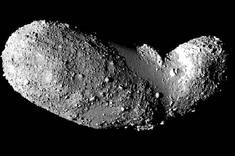An asteroid the size of a pickup truck narrowly missed Earth late last night (Jan. 29), just hours after scientists first spotted the space rock.
The near-Earth asteroid, known as 2017 BH30, zoomed within 32,200 miles (51,820 kilometers) of the planet , about 13 percent the distance from Earth to the moon. Closest approach occurred at 11:59 p.m. EST last night (0459 GMT today, Jan. 30), according to astronomers with the Minor Planet Center in Cambridge, Massachusetts.
The 2017 BH30 object is about 19 feet (5.8 meters) wide, said scientists at NASA’s Jet Propulsion Laboratory in Pasadena, California. Space rocks of this size pose no appreciable threat to Earth or its inhabitants, researchers have said. [Potentially Dangerous Asteroids in Images ]
For a bit of perspective: The object that exploded over the Russian city of Chelyabinsk in February 2013, injuring more than 1,000 people, was estimated to be about 65 feet (20 m) wide. But asteroids have to be much bigger than that — at least 0.6 miles (1 km) or so in diameter — to wreak destruction on a global scale, astronomers have said.

0 of 10 questions complete
The object 2017 BH30 was discovered yesterday by scientists at the Catalina Sky Survey, which is based in Tucson, Arizona. The asteroid takes about 3.8 Earth years to complete one lap around the sun, traveling along a much more elliptical orbit than Earth’s. This space rock gets as close to the sun as 0.81 astronomical units (AU) and as far away as 3.84 AU, according to the Minor Planet Center. (One AU is the average Earth-sun distance, about 93 million miles, or 150 million km.)
Astronomers have discovered more than 15,000 near-Earth asteroids to date, but the catalogue is far from complete; millions of rocks are thought to reside in Earth’s neck of the cosmic woods.
Follow Mike Wall on Twitter @michaeldwall and Google+ . Follow us @Spacedotcom , Facebook or Google+ . Originally published on Space.com .

Comments are closed.